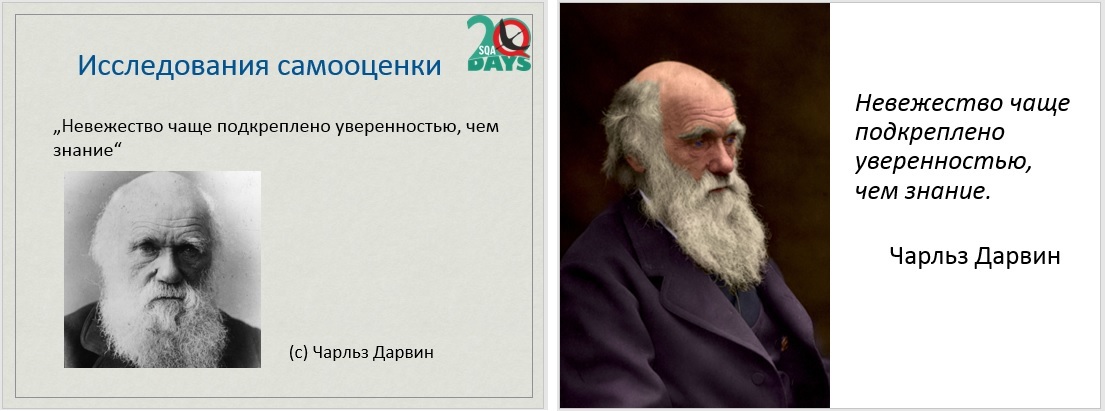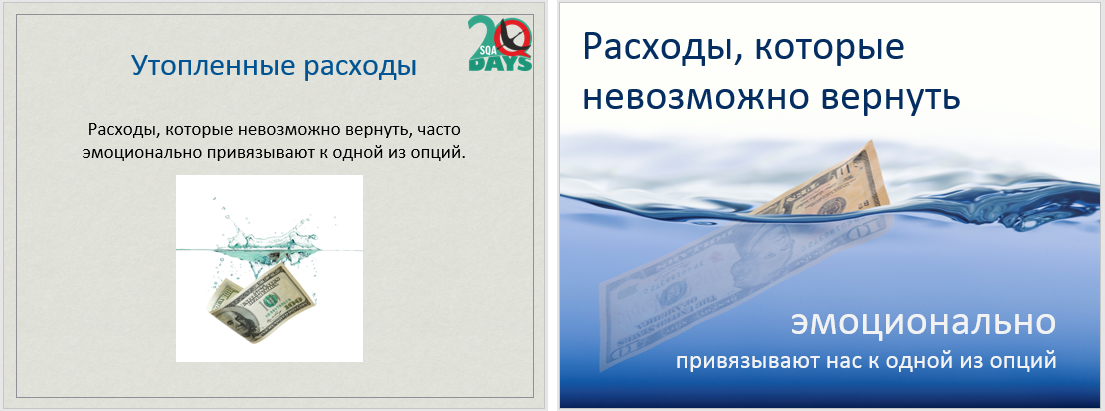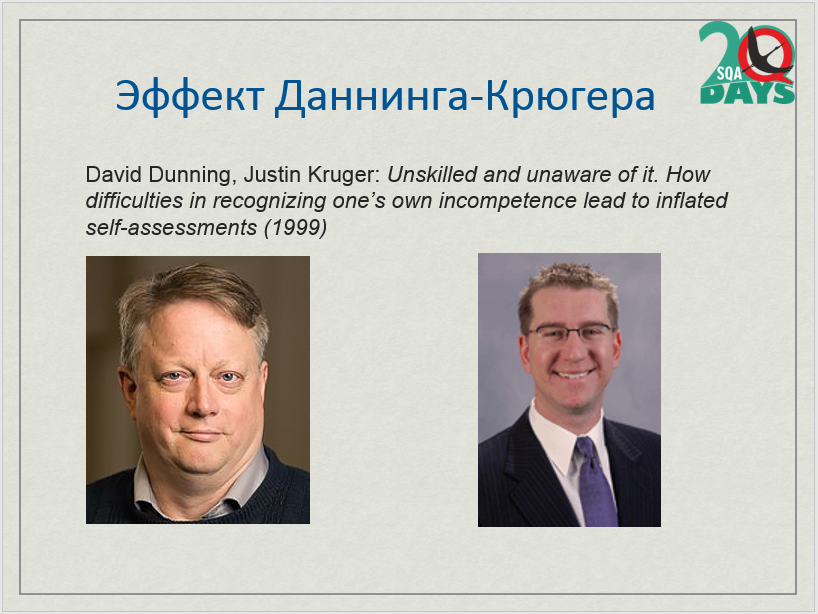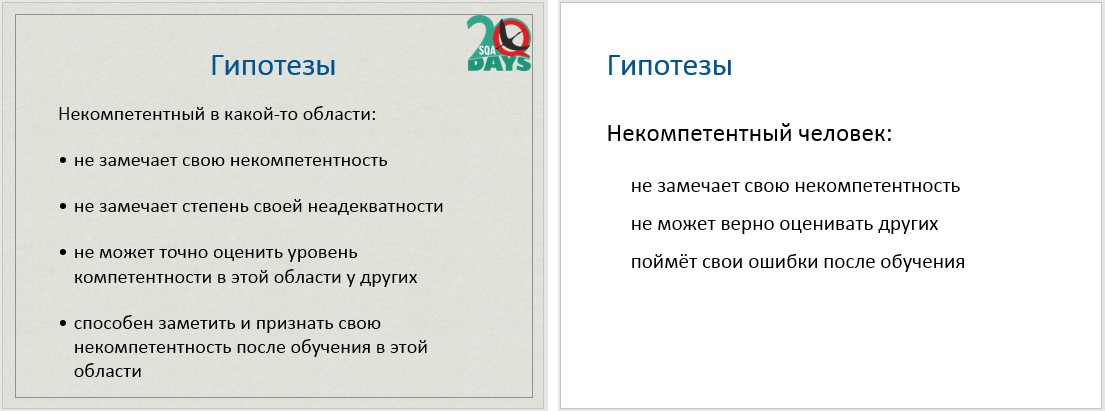Analysis of the report of Alexey Vinogradov about cargo cult and other diseases
Hello everyone, Roman Poborchy again with you, and today, for a change, we are not looking at a hardcore-technical report, but rather a managerial report. He was introduced to SQADays-20 . The author is Alexei i_vino Vinogradov, and his presentation is devoted to the cargo cult, the not-invented-here syndrome and the Dunning-Kruger effect.
Slides here:
')
The report is enlightening, and thanks to Alexey for this. People definitely need to talk about conceptual problems from time to time. It is difficult, and the efficiency of this work is small, but you still need to do it, because if not us, then who.
Before I got acquainted with the report, I could not confidently answer what the Dunning-Kruger effect is, and I met quite a few people unfamiliar with other topics of the report.
Here I found out about three (spoiler: four, there is a bonus track) typical brain breakdowns that are often found in IT companies. What do I need to do with this knowledge? How to behave?
In response to this question, I never accept "told, just to know." In ordinary life, we do not inform people about something just like that. Almost always we are waiting for a specific reaction to our information. Sometimes it is easy to guess what kind of reaction it is, and sometimes the listener needs to say this explicitly.
Do we want people to recognize these problems in others? In itself? How? How to fight if recognized? These questions hardly have an unequivocal answer, but just here personal experience and the opinion of the speaker would be very appropriate.
Two of the four points (not invented here and drowned money) have specific recommendations, which is good. But the cult of cargo, and especially the effect of Dunning-Kruger, seem to be divorced from practice.
I am afraid the audience left the report with the thought that a cargo cult is somewhere far away from the Papuans. We scrub normally we introduce: Vasya read a book. And we will not trust the only junior tester to organize the testing process. No no. He has not been a junior for half a year.
In fact, our whole life is saturated with manifestations of the cult of cargo and, perhaps, it was worthwhile for people to point out at them, even eating it will cause them butthört. Especially if it causes them to batthert.
Who in the company passwords automatically foul once a quarter, and until you change, do not go into the network?
Who uses the Internet bank from the phone and receives SMS for two-factor authorization on the same phone ?
Who has target quality metrics in your company that you follow? Conversion, user retention, user engagement, is that all? And who understands how to calculate the error of these measurements? And who says “we are a data-driven company”?
Revelations google dude all read? I have a dozen and a half reposts in my facebook feed, more this year there were only waiting messages, so the text is popular. Everything is rational there, but it is necessary to apply this wisdom intelligently. For example: hire HR as early as possible; when you have 30 people in the company, it's time. Who has HR in the company? And who does HR do something more useful than employment records? Who generally understands what the function of HR is?
In general, if such examples were possible to get in the amount of at least half of the audience, then someone would have thought how much around the things that we repeat exactly according to recommendations that are not suitable for our case.
This item seems to me to set out well. The preference for free solutions, an energetic search for flaws in third-party products, and other effects really do occur. For such symptoms, you can make a diagnosis yourself, and the recommendations collected on slide 24 are quite understandable and helpful.
Replica to the side: Joel Spolsky on the slide is signed as CEO of StackOverflow, and not as the author of the blog Joel on Software. That is correct, now he is known more as a CEO, but every time I am surprised to understand this. And there are people who have not read his blog. Feel like a dinosaur.
People who after the story of Alexey will consider that they understood the effect of Dunning-Kruger will serve as its living manifestations. But not only they. The sayings “every taxi driver knows how to run the country” and “bought a DSLR is already a photographer” is also about this effect.
In general, examples from the practice and personal experience of the speaker are especially lacking in this section; here the story turned out to be 100% theoretical. To think and fix something in the world and in yourself, as in the case of the cargo cult, the viewer must recognize himself in a negative character. And the hero is not.
To cause a hero, I would look for typical novice errors in various areas related to IT. Errors that are made "out of common sense" and go away, it is worthwhile for a person to learn a materiel. For example, when communicating with different people about a / b testing, I ask what statistical criteria they use. In many cases, it turns out that no, but they simply compare the average values of the metrics in the exelcicle and are happy if it turned out to be “5% more”, this is their big data. I would recall some damned position in which every newcomer must take the same actions, wondering how this predecessors did not solve all the problems in such an obvious way. By the time the fallacy of the method became apparent, it was time to prepare three envelopes.
In general, and here, I think, it was not obvious to the audience that the Dunning-Kruger effect is not some kind of exotic, but it concerns literally everyone.
Before commenting on specific elements, I want to note two things that Alexey could have done better in the presentation template.
First, the place of the logo, if you want to turn it on - in the lower right corner. At the top right he at least limits the length of the title of the slide, one thing is a sufficient reason to move it.
Secondly, templates with frames severely limit the flight of thought. They not only reduce the available space, but also do not allow any object or picture to be cut off by the border of the slide. It is not comfortable.
I tell all the speakers and I’m not tired of repeating it: the pictures should be large. If there is nothing on the slide except for the picture, there should not be anything in it except for the picture.
Below we will see more examples, and right now look at the two slides, which are especially strongly asked to correct them:

In the first case, the entire content of the content consists of a graphic, and the titles of the graphic and the framing slide coincide with the accuracy of the language. Conclusion: framing slide is not needed.
In the second case, there is not only nothing on the slide, except for the picture, but the picture already conveniently has a 4x3 format. It is very easy to stretch it to the full screen, and this is how it should be done.
Central symmetry should be avoided; any composition specialist will say this, and not just such a Dunning-Kruger effect victim like me. In addition to real, but difficult to prove aesthetic damage, the location of elements in the center from top to bottom inefficiently consumes space. This is noticeable, for example, on slides with quotations, there are quite a lot of them in the presentation. Compare (slide 31):

By removing the heading repeated on several slides and moving the text of the quotation from the middle position to the right, we free up space for a large portrait (it seems to Leo Tolstoy to look like it anyway), and also get a natural place to sign. Left-right in such slides can be interleaved depending on where the face is turned in the portrait (should be obtained to the center, not to the edge).
Another example is a slide about money drowned:

The big picture and the departure from the central symmetry make it more memorable.
But alignment, on the contrary, is important. It is not just not necessary to avoid it, its absence makes slides inaccurate. In our case it happened in several places. For example, note that the portraits of Dunning and Kruger differ slightly in aspect ratio and location, visual discomfort arises. For some, it will sound like cockroach slippers, but the pictures for the presentation need to be cropped.

For my taste, the text on the slides is a bit too much. Frequent (pseudo) argument for the abundance of words - care for those who have not been to speak. For them, it’s worth writing an article and linking it to a presentation. Those who request slides from you personally, you can immediately send this article. But on the report the viewer will not have to be torn between the slides and the speaker and compare the text that you speak with the one that you demonstrate:

We remove multiple “in this area”, glue the first two bullets, and people need to read much less. I would also show the text on this slide consistently, so that the audience does not overtake the speaker's thought.
This is not the only or even the most difficult slide with an abundance of text, but you should treat them all equally.
Please note that Alexey will perform at the St. Petersburg Heisenbag in June. His report this time will be technical. Alexey has a lot of interesting material in stock, so we are looking forward to it.
If you want to get feedback on your performance, I’ll be happy to give it to you.
Slides here:
')
Plot
The report is enlightening, and thanks to Alexey for this. People definitely need to talk about conceptual problems from time to time. It is difficult, and the efficiency of this work is small, but you still need to do it, because if not us, then who.
Before I got acquainted with the report, I could not confidently answer what the Dunning-Kruger effect is, and I met quite a few people unfamiliar with other topics of the report.
findings
Here I found out about three (spoiler: four, there is a bonus track) typical brain breakdowns that are often found in IT companies. What do I need to do with this knowledge? How to behave?
In response to this question, I never accept "told, just to know." In ordinary life, we do not inform people about something just like that. Almost always we are waiting for a specific reaction to our information. Sometimes it is easy to guess what kind of reaction it is, and sometimes the listener needs to say this explicitly.
Do we want people to recognize these problems in others? In itself? How? How to fight if recognized? These questions hardly have an unequivocal answer, but just here personal experience and the opinion of the speaker would be very appropriate.
Two of the four points (not invented here and drowned money) have specific recommendations, which is good. But the cult of cargo, and especially the effect of Dunning-Kruger, seem to be divorced from practice.
Cargo cult
I am afraid the audience left the report with the thought that a cargo cult is somewhere far away from the Papuans. We scrub normally we introduce: Vasya read a book. And we will not trust the only junior tester to organize the testing process. No no. He has not been a junior for half a year.
In fact, our whole life is saturated with manifestations of the cult of cargo and, perhaps, it was worthwhile for people to point out at them, even eating it will cause them butthört. Especially if it causes them to batthert.
Who in the company passwords automatically foul once a quarter, and until you change, do not go into the network?
Who uses the Internet bank from the phone and receives SMS for two-factor authorization on the same phone ?
Who has target quality metrics in your company that you follow? Conversion, user retention, user engagement, is that all? And who understands how to calculate the error of these measurements? And who says “we are a data-driven company”?
Revelations google dude all read? I have a dozen and a half reposts in my facebook feed, more this year there were only waiting messages, so the text is popular. Everything is rational there, but it is necessary to apply this wisdom intelligently. For example: hire HR as early as possible; when you have 30 people in the company, it's time. Who has HR in the company? And who does HR do something more useful than employment records? Who generally understands what the function of HR is?
In general, if such examples were possible to get in the amount of at least half of the audience, then someone would have thought how much around the things that we repeat exactly according to recommendations that are not suitable for our case.
Not invented here
This item seems to me to set out well. The preference for free solutions, an energetic search for flaws in third-party products, and other effects really do occur. For such symptoms, you can make a diagnosis yourself, and the recommendations collected on slide 24 are quite understandable and helpful.
Replica to the side: Joel Spolsky on the slide is signed as CEO of StackOverflow, and not as the author of the blog Joel on Software. That is correct, now he is known more as a CEO, but every time I am surprised to understand this. And there are people who have not read his blog. Feel like a dinosaur.
Dunning-Kruger effect
People who after the story of Alexey will consider that they understood the effect of Dunning-Kruger will serve as its living manifestations. But not only they. The sayings “every taxi driver knows how to run the country” and “bought a DSLR is already a photographer” is also about this effect.
In general, examples from the practice and personal experience of the speaker are especially lacking in this section; here the story turned out to be 100% theoretical. To think and fix something in the world and in yourself, as in the case of the cargo cult, the viewer must recognize himself in a negative character. And the hero is not.
To cause a hero, I would look for typical novice errors in various areas related to IT. Errors that are made "out of common sense" and go away, it is worthwhile for a person to learn a materiel. For example, when communicating with different people about a / b testing, I ask what statistical criteria they use. In many cases, it turns out that no, but they simply compare the average values of the metrics in the exelcicle and are happy if it turned out to be “5% more”, this is their big data. I would recall some damned position in which every newcomer must take the same actions, wondering how this predecessors did not solve all the problems in such an obvious way. By the time the fallacy of the method became apparent, it was time to prepare three envelopes.
In general, and here, I think, it was not obvious to the audience that the Dunning-Kruger effect is not some kind of exotic, but it concerns literally everyone.
Slides
Before commenting on specific elements, I want to note two things that Alexey could have done better in the presentation template.
First, the place of the logo, if you want to turn it on - in the lower right corner. At the top right he at least limits the length of the title of the slide, one thing is a sufficient reason to move it.
Secondly, templates with frames severely limit the flight of thought. They not only reduce the available space, but also do not allow any object or picture to be cut off by the border of the slide. It is not comfortable.
Images
I tell all the speakers and I’m not tired of repeating it: the pictures should be large. If there is nothing on the slide except for the picture, there should not be anything in it except for the picture.
Below we will see more examples, and right now look at the two slides, which are especially strongly asked to correct them:

In the first case, the entire content of the content consists of a graphic, and the titles of the graphic and the framing slide coincide with the accuracy of the language. Conclusion: framing slide is not needed.
In the second case, there is not only nothing on the slide, except for the picture, but the picture already conveniently has a 4x3 format. It is very easy to stretch it to the full screen, and this is how it should be done.
Symmetry
Central symmetry should be avoided; any composition specialist will say this, and not just such a Dunning-Kruger effect victim like me. In addition to real, but difficult to prove aesthetic damage, the location of elements in the center from top to bottom inefficiently consumes space. This is noticeable, for example, on slides with quotations, there are quite a lot of them in the presentation. Compare (slide 31):

By removing the heading repeated on several slides and moving the text of the quotation from the middle position to the right, we free up space for a large portrait (it seems to Leo Tolstoy to look like it anyway), and also get a natural place to sign. Left-right in such slides can be interleaved depending on where the face is turned in the portrait (should be obtained to the center, not to the edge).
Another example is a slide about money drowned:

The big picture and the departure from the central symmetry make it more memorable.
But alignment, on the contrary, is important. It is not just not necessary to avoid it, its absence makes slides inaccurate. In our case it happened in several places. For example, note that the portraits of Dunning and Kruger differ slightly in aspect ratio and location, visual discomfort arises. For some, it will sound like cockroach slippers, but the pictures for the presentation need to be cropped.

Text
For my taste, the text on the slides is a bit too much. Frequent (pseudo) argument for the abundance of words - care for those who have not been to speak. For them, it’s worth writing an article and linking it to a presentation. Those who request slides from you personally, you can immediately send this article. But on the report the viewer will not have to be torn between the slides and the speaker and compare the text that you speak with the one that you demonstrate:

We remove multiple “in this area”, glue the first two bullets, and people need to read much less. I would also show the text on this slide consistently, so that the audience does not overtake the speaker's thought.
This is not the only or even the most difficult slide with an abundance of text, but you should treat them all equally.
Announcement
Please note that Alexey will perform at the St. Petersburg Heisenbag in June. His report this time will be technical. Alexey has a lot of interesting material in stock, so we are looking forward to it.
Regular Parsing
If you want to get feedback on your performance, I’ll be happy to give it to you.
What is needed for this?
All this needs to be sent to the habrauzer p0b0rchy , that is, to me. I promise that the review will be constructive and polite, as well as highlight the positive aspects, and not just what needs to be improved.
- Link to the video recording of the speech.
- Link to slides.
- Application from the author. Without the consent of the speaker himself, we will not analyze anything.
All this needs to be sent to the habrauzer p0b0rchy , that is, to me. I promise that the review will be constructive and polite, as well as highlight the positive aspects, and not just what needs to be improved.
Source: https://habr.com/ru/post/321850/
All Articles